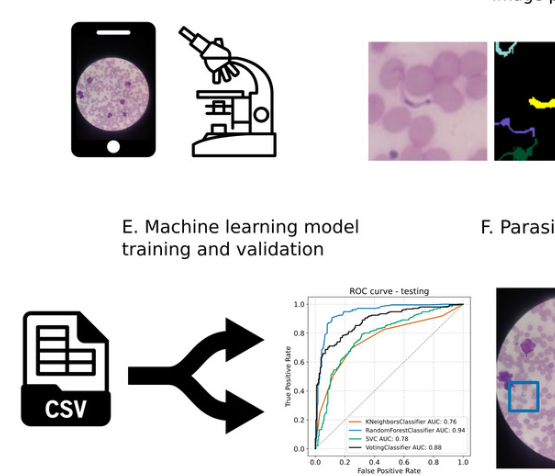Automatic detection of the parasite Trypanosoma cruzi in blood smears using a machine learning approach applied to mobile phone images
Chagas disease is a life-threatening illness caused by the parasite Trypanosoma cruzi. The diagnosis of the acute form of the disease is performed by trained microscopists who detect parasites in blood smear samples. Since this method requires a dedicated high-resolution camera system attached to the microscope, the diagnostic method is more expensive and often prohibitive for low-income settings. Here, we present a machine learning approach based on a random forest (RF) algorithm for the detection and counting of T. cruzi trypomastigotes in mobile phone images. We analyzed micrographs of blood smear samples that were acquired using a mobile device camera capable of capturing images in a resolution of 12 megapixels. We extracted a set of features that describe morphometric parameters (geometry and curvature), as well as color, and texture measurements of 1,314 parasites. The features were divided into train and test sets (4:1) and classified using the RF algorithm. The values of precision, sensitivity, and area under the receiver operating characteristic (ROC) curve of the proposed method were 87.6%, 90.5%, and 0.942, respectively. Automating image analysis acquired with a mobile device is a viable alternative for reducing costs and gaining efficiency in the use of the optical microscope.
Authors
Morais, Mauro Cesar Cafundo; Silva, Diogo; Milagre, Matheus Marques; de Oliveira, Maykon Tavares; Pereira, Thais; Silva, Joi£o Santana; Costa, Luciano da F; Minoprio, Paola; Junior, Roberto Marcondes Cesar; Gazzinelli, Ricardo;
External link
Publication Year
Publication Journal
Associeted Project
User-friendly computational Tools
Lista de serviços
-
Genomic analyses reveal broad impact of miR-137 on genes associated with malignant transformation and neuronal differentiation in glioblastoma cells.Genomic analyses reveal broad impact of miR-137 on genes associated with malignant transformation and neuronal differentiation in glioblastoma cells.
-
RNA-Binding Protein Musashi1 Is a Central Regulator of Adhesion Pathways in Glioblastoma.RNA-Binding Protein Musashi1 Is a Central Regulator of Adhesion Pathways in Glioblastoma.
-
MicroRNA Transcriptome Profiling in Heart of Trypanosoma cruzi-Infected Mice: Parasitological and Cardiological Outcomes.MicroRNA Transcriptome Profiling in Heart of Trypanosoma cruzi-Infected Mice: Parasitological and Cardiological Outcomes.
-
Genome mapping and expression analyses of human intronic noncoding RNAs reveal tissue-specific patterns and enrichment in genes related to regulation of transcription.Genome mapping and expression analyses of human intronic noncoding RNAs reveal tissue-specific patterns and enrichment in genes related to regulation of transcription.
-
Antimicrobial peptide LL-37 participates in the transcriptional regulation of melanoma cells.Antimicrobial peptide LL-37 participates in the transcriptional regulation of melanoma cells.
-
Down-regulation of 14q32-encoded miRNAs and tumor suppressor role for miR-654-3p in papillary thyroid cancer.Down-regulation of 14q32-encoded miRNAs and tumor suppressor role for miR-654-3p in papillary thyroid cancer.
-
Integration of miRNA and gene expression profiles suggest a role for miRNAs in the pathobiological processes of acute Trypanosoma cruzi infection.Integration of miRNA and gene expression profiles suggest a role for miRNAs in the pathobiological processes of acute Trypanosoma cruzi infection.
-
Integrative Biology Approaches Applied to Human DiseasesIntegrative Biology Approaches Applied to Human Diseases
-
Proteomics reveals disturbances in the immune response and energy metabolism of monocytes from patients with septic shock.Proteomics reveals disturbances in the immune response and energy metabolism of monocytes from patients with septic shock.
-
Genomics, epigenomics and pharmacogenomics of Familial Hypercholesterolemia (FHBGEP): A study protocol.Genomics, epigenomics and pharmacogenomics of Familial Hypercholesterolemia (FHBGEP): A study protocol.
-
Melatonin-Index as a biomarker for predicting the distribution of presymptomatic and asymptomatic SARS-CoV-2 carriersMelatonin-Index as a biomarker for predicting the distribution of presymptomatic and asymptomatic SARS-CoV-2 carriers
-
Profiling plasma-extracellular vesicle proteins and microRNAs in diabetes onset in middle-aged male participants in the ELSA-Brasil study.Profiling plasma-extracellular vesicle proteins and microRNAs in diabetes onset in middle-aged male participants in the ELSA-Brasil study.
-
Big Data and machine learning in cancer theranosticsBig Data and machine learning in cancer theranostics
-
Genomic positional conservation identifies topological anchor point RNAs linked to developmental loci.Genomic positional conservation identifies topological anchor point RNAs linked to developmental loci.
-
Integrative systems immunology uncovers molecular networks of the cell cycle that stratify COVID-19 severityIntegrative systems immunology uncovers molecular networks of the cell cycle that stratify COVID-19 severity

